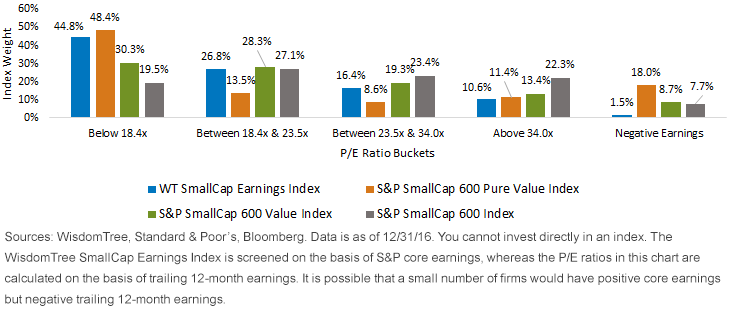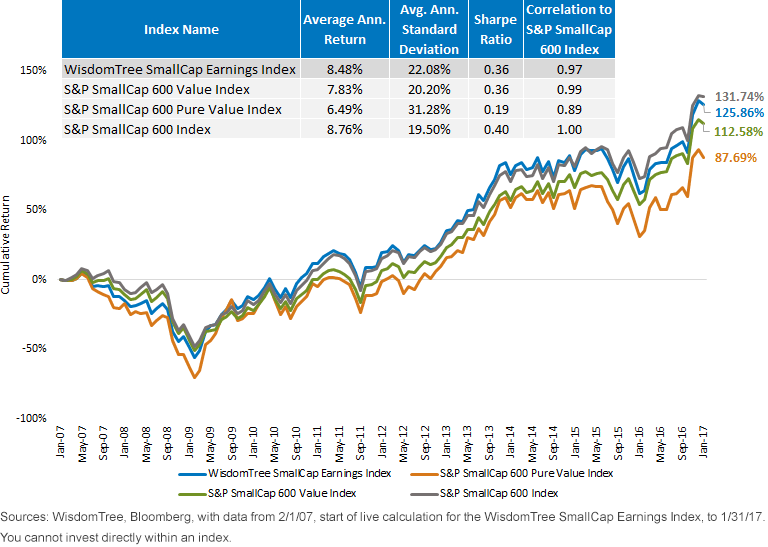How to Access Small-Cap Value


Over a long period of time, many studies have come to a similar conclusion: Small-cap stocks, screened in some manner for reasonable valuation, have been very strong performers.
What Does Small-Cap Value Mean?
“Value” is a term that is used in different ways in the financial industry. First of all, how do you define “value”? Low price-to-earnings (P/E) ratio? Low price-to-book value ratio? A low price relative to a mix of different fundamentals? Not to mention how the allocation should be divided among different-value stocks—should the company with the most “value” get the most weight or should the biggest company by market capitalization?1
- The S&P SmallCap 600 Value Index focuses on selecting stocks with low prices relative to three metrics: book value, earnings and sales. It’s notable that, as of December 31, 2016, there were 181 stocks included in this index that were also included within the S&P SmallCap 600 Growth Index. This happens because, although approximately one-third of the S&P SmallCap 600 Index universe is clearly value and one-third is clearly growth, there is a segment in the middle where weights of stocks are split between value and growth.
- On the other hand, while the S&P SmallCap 600 Pure Value Index focuses on stocks with low prices relative to the same fundamentals, there is 0% overlap with the S&P SmallCap 600 Pure Growth Index. Instead of weight being proportional to market capitalization, another interesting element is that constituents are weighted in accordance with their attractiveness. In other words, lower prices relative to the defined fundamentals receive higher weights.
What Is WisdomTree’s SmallCap Earnings Approach?
Instead of directly placing the word “value” in the name of the Index or indicating that the concept of value is the primary focus, WisdomTree instead focuses on earnings. Within U.S. small caps, this leads to the following:
- Elimination of unprofitable companies: Every company within the WisdomTree SmallCap Earnings Index has generated positive, cumulative earnings2 over the prior four quarters leading up to the annual screening date, November 30 of each year.
- Weighting by profits, not market capitalization: Companies in the WisdomTree SmallCap Earnings Index are weighted based on the profits that they generate, therefore delinking a rising share price from a greater index exposure.
- In practice, this creates a situation where companies whose share prices rise but earnings stagnate will tend to see weights decreased. Conversely, if company earnings thrive and growth but share prices stagnate, then weight would be added. In a way, the process adds to areas where earnings have become less expensive and takes away from areas where earnings have become more expensive.
How to think about "Value" for the S&P SmallCap 600 Starting Universe & the WisdomTree SmallCap Earnings Index

- Pushing weight to lower P/E stocks: Both the WisdomTree SmallCap Earnings Index and the S&P SmallCap 600 Pure Value Index are not market capitalization-weighted and are clearly pushing more exposure into stocks in the lowest P/E quartile, specifically those stocks with P/E ratios below 18.4x. It is notable that the WisdomTree SmallCap Earnings Index had 71.6% of its weight in stocks below the median S&P SmallCap 600 Index P/E ratio of 23.5x, whereas the S&P SmallCap 600 Pure Value Index only had 61.9% of its weight in stocks with P/E ratios below this level.
- How negative earnings are dealt with: It’s interesting that the S&P SmallCap 600 Pure Value Index had 18% of its weight in stocks with negative earnings over the prior 12-month period. The WisdomTree SmallCap Earnings Index—with earnings measured in equivalent manner—only had 1.5% exposure to these firms, which is a big difference.
The Risk of “Value” Approaches to Small-Cap Stocks

For definitions of terms in the chart, visit our glossary.
- The value style can fall out of favor: For the first 10-year period of its live calculation, the WisdomTree SmallCap Earnings Index saw a period where the growth style dramatically outperformed the value style in U.S. equities. Choosing the value style over this period would therefore lead to underperformance.
- WisdomTree SmallCap Earnings is more than value: Since we never know which style would outperform ahead of time (it would be quite nice if we did), a key focus could be on mitigating the risk of making the wrong choice. The WisdomTree Index takes an extremely broad approach—the key being eliminating firms with negative core earnings. This, combined with weighting by earnings, did tend to lower the P/E ratio, but there is nothing that would say profitable growth companies could not also gain inclusion.
Rebalancing Has Been about More than Valuation
A critical focus of the annual rebalance has been lowering P/E ratios, but we also would note the following:3
- Weighted average market capitalization exposure of the Index has tended to fall, therefore refocusing on the appropriate small-cap size segment.
- Return on equity (ROE) or return on assets (ROA) has tended to rise, especially since firms with negative earnings have been eliminated.
Tapping into what many would call the “size” or “quality” factors therefore diversifies the set of environments where the WisdomTree SmallCap Earnings Index can thrive, as opposed to purely focusing on “value.”
1Sources for information below bullets: S&P Index Methodology Document, Bloomberg.
2Earnings represent S&P’s measure of core earnings, different from the trailing 12-month earnings that may have greater potential to be impacted by one-time or extraordinary events.
3Sources: WisdomTree, Standard & Poor’s, with annual index rebalances measured based on screening dates from 11/30/07 to 11/30/16.
Important Risks Related to this Article
Investments focusing on certain sectors and/or smaller companies increase their vulnerability to any single economic or regulatory development.

Christopher Gannatti began at WisdomTree as a Research Analyst in December 2010, working directly with Jeremy Schwartz, CFA®, Director of Research. In January of 2014, he was promoted to Associate Director of Research where he was responsible to lead different groups of analysts and strategists within the broader Research team at WisdomTree. In February of 2018, Christopher was promoted to Head of Research, Europe, where he was based out of WisdomTree’s London office and was responsible for the full WisdomTree research effort within the European market, as well as supporting the UCITs platform globally. In November 2021, Christopher was promoted to Global Head of Research, now responsible for numerous communications on investment strategy globally, particularly in the thematic equity space. Christopher came to WisdomTree from Lord Abbett, where he worked for four and a half years as a Regional Consultant. He received his MBA in Quantitative Finance, Accounting, and Economics from NYU’s Stern School of Business in 2010, and he received his bachelor’s degree from Colgate University in Economics in 2006. Christopher is a holder of the Chartered Financial Analyst Designation.

